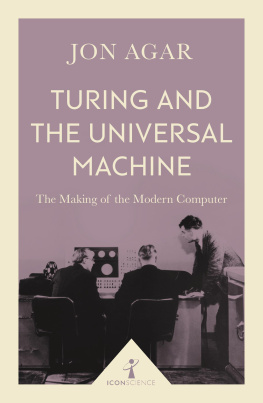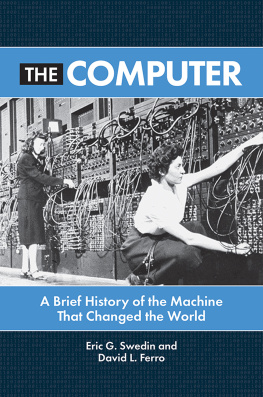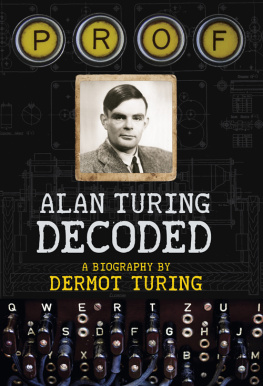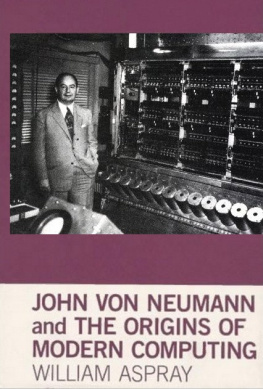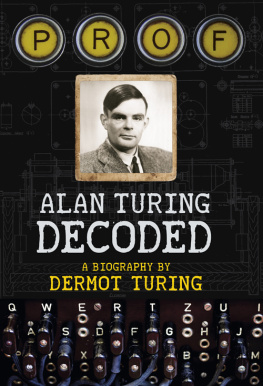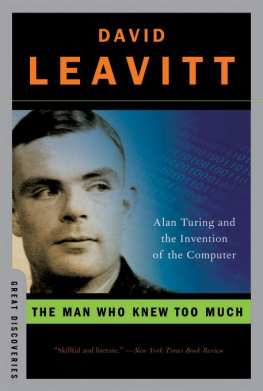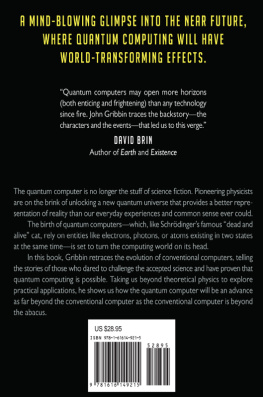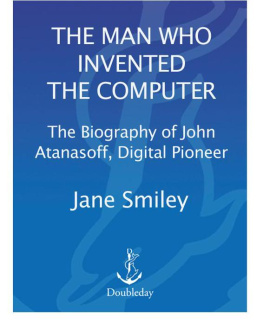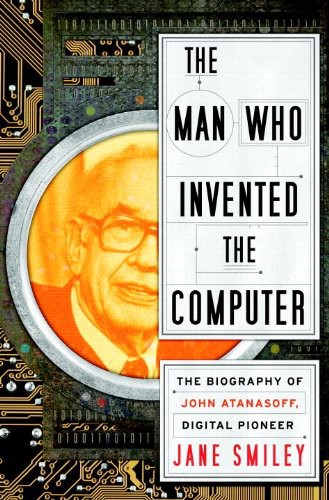
Copyright 2010 by Jane Smiley
All rights reserved. Published in the United States by Doubleday,
a division of Random House, Inc., New York, and in Canada
by Random House of Canada Limited, Toronto.
www.doubleday.com
DOUBLEDAY and the DD colophon are registered
trademarks of Random House, Inc.
Library of Congress Cataloging-in-Publication Data
Smiley, Jane.
The man who invented the computer : the biography of
John Atanasoff, digital pioneer / Jane Smiley.1st ed.
p. cm.
1. Atanasoff, John V. (John Vincent) 2. Computer scientistsUnited StatesBiography. 3. InventorsUnited StatesBiography. 4. PhysicistsIowaBiography. 5. College teachersIowaBiography. 6. Electronic digital computersHistory20th century. 7. Sperry Rand CorporationHistory20th century. 8. PatientsUnited StatesHistory20th century. 9. Intellectual propertyUnited StatesHistory20th century. I. Title.
QA76.2.A75S64 2010
004.092dc22
[B]
2010018887
eISBN: 978-0-385-53372-0
v3.1
Mathematical reasoning may be regarded rather schematically as the exercise of a combination of two faculties, which we may call intuition and ingenuity.
Alan Turing, Systems of Logic Based on Ordinals, 1939
Contents
Introduction
T he story of how the computer on my desk got to me is one of the most peculiar tales of the twentieth century, and it demonstrates many tropes often considered merely literaryperipeteia (a sudden reversal in the plot), hamartia (an error in judgment or a mistake), anagnorisis (unexpected recognition), catharsis (strong feelings), as well as significant amounts of tragedy, terror, and pathos, and even some comedy. Many characters took part, and they did, indeed, act in charactersome were dedicated, brave, enterprising, and lucky. Others were hotheaded, deceptive, foolish, and unfortunate. All were brilliant, but the story of the computer shows how they were brilliant in different ways. At least one, the most sociable one, turns out also to have been the most mysterious but maybe the most pivotal. And oddly enough, no inventor of the computer got rich off the invention, even though a few tried.
The inventor of the computer was a thirty-four-year-old associate professor of physics at Iowa State College named John Vincent Atanasoff. There is no doubt that he invented the computer (his claim was affirmed in court in 1978) and there is no doubt that the computer was the most important (though not the most deadly) invention of the twentieth century. But on the MIT Inventor Archive, there is no Atanasoff between Barbara Askins (Method of Obtaining Intensified Image from Developed Photographic Films and Plates) and Mike Augspurger (Handcycle). Where and when did Atanasoff invent the computer? In a roadhouse in Rock Island, Illinois, while having a drink. He jotted his notes on a cocktail napkin.
At the time John Vincent Atanasoff conceived of his invention, he lived in Ames, Iowa, north of Des Moines, and taught in the physics department at Iowa State College (later to be renamed Iowa State University). He had been attempting to come up with a calculating machine since the early thirties, and he had tried all sorts of ideas. On that night in December 1937, frustrated that his work seemed stalled and baffling, he left his house on Woodland Street after supper and went back to his office in the physics building, but that was no good, either. So he jumped in his new car and headed for the Lincoln Highwaythe two-lane road that was the first highway to connect the East Coast with the West Coast (Times Square in New York with Lincoln Park in San Francisco). Atanasoff drove east for some sixty or seventy miles, through the flat prairies of Story County and Marshall County, to Tama, then he turned southeast toward Marengo. He drifted past Iowa City on Highway 6. The landscape of eastern Iowa was rolling and foresteddecidedly different from the flatlands around Ames. He drove rather fast, and so his trip demanded concentration and was a relief from his recent obsessive focus on his computing problem.
Atanasoff later recalled, I had reached the Mississippi River and was crossing into Illinois at a place where there are three cities one of which is Rock Island. I drove into Illinois and turned off the highway into a little road, and went into a roadhouse, which had bright lights I sat down and ordered a drink As the delivery of the drink was made, I realized that I was no longer so nervous and my thoughts turned again to computing machines.
The youthful professor came up with four ideas about how a computer might work. They came to him all at oncefour parts of a system that he had not been able to get a handle on in the previous five to seven years of concentrated effort. After he finished his drink (or two, though his son later maintained that more than one drink tended to put him to sleep, and that he had been known to stretch out on the carpet at parties after two), he got back into his car, drove home, and set about working out his ideas in detail. Within two years, he and a graduate student named Clifford Berry had constructed a working prototype at a cost of $650 ($450 to pay his assistant and $200 for materials).
If this sounds like the American dream, it isAtanasoffs invention of the computer came about as a result of immigration to the United States from a troubled area, internal migration around the United States in search of better opportunities, and a system of general, and inexpensive, public education that was based upon the land-grant universities established by the Morrill Act of 1862. Atanasoffs American dream also included wholesome family values, innovative genius, and, eventually, vindication, but the path from those notes written on a napkin in Rock Island to this computer on my desk was a tortuous one. The story of the invention of the computer is a story of how a general need is met by idiosyncratic minds, a story of how a thing that exists is a thing that could have easily existed in another way, or, indeed, not existed at all.
But although this volume is a biography of Atanasoff and focuses on him, his story can only be told in the context of other stories, because in that December of 1937, others too were pondering the difficulties of calculation. Alan Turing, a visiting fellow at Princeton, was wondering if the Liverpool tide-predicting machine, a system of pulleys and gears used to measure and predict tides on the river Mersey, could serve as a core idea for a general calculating machine. Tommy Flowers, an engineer at the General Post Office outside London, was wondering if vacuum tubes (or valves as they were called in England) could be used for telephone system relays. Max Newman, a Cambridge mathematician, was nervous about what was going on in Europe but hadnt turned his thoughts to computers yet. John Mauchly, aged thirty, was teaching at Ursinus College in Pennsylvaniahis passion was weather prediction, and he had his students attempting to find mathematical correlations between U.S. rainfall and patterns of solar rotation. J. Presper Eckert, only eighteen, was applying to college at MIT, though in the end he went to business school at the University of Pennsylvania. Konrad Zuse, in Berlin, had already built one computer (the Z1) in his parents apartment. He later said that if the building had not been bombed, he would not have been able to get his machine out of the apartment. John von Neumann, born in Hungary but living in Princeton, New Jersey, had become so convinced that war in Europe was inevitable that he had applied for U.S. citizenship. He received his naturalization papers in December 1937. Von Neumann was one of the most talented mathematicians of his day, but he wasnt yet involved with computers. It is the weaving of these individual stories that makes up the whole story and causes it to become not merely the tale of an invention, but a saga of how the mind works, and of how the world works.




